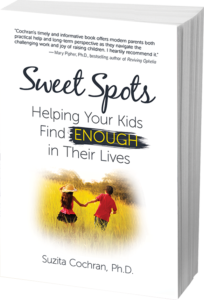 My neighbor Kim (see Boys Babysitting: Kim was Right) suggested starting a neighborhood babysitting co-op. In the end three families were able to participate. We arranged for one couple to care for all seven kids one evening, every three weeks. So, one Saturday evening of babysitting equals two Saturday evenings free.
My neighbor Kim (see Boys Babysitting: Kim was Right) suggested starting a neighborhood babysitting co-op. In the end three families were able to participate. We arranged for one couple to care for all seven kids one evening, every three weeks. So, one Saturday evening of babysitting equals two Saturday evenings free.
We’re still working out the kinks, but it seems to be progressing well so far. Of course on Todd’s and my first free Saturday evening, we were home with a feverish Annie. Ah, parenthood.
Our kids are the oldest in the co-op group. The other children range from ages three to five. How quickly one forgets what it’s like to live with young children:
Tiny fingers that adore digging in dirt. Little feet that never keep shoes or socks on long. Small attention spans housed within little bodies. About the only items not small are the huge emotions only barely under their tiny master’s control.
Life with young children is like nothing else. Todd and I used to call those days Double Playground Days. One or both of us would take our little ones to a playground in the morning, where we’d last approximately two hours. We’d return home for lunch and nap or quiet time, then head to another park for the late afternoon. I’m tired just remembering this.
Spending time with our neighbors’ kids at the babysitting co-op reminded me of all the parenting books I desperately devoured in between playground trips back then. Now that those years have mostly passed, I can look back on this reading and pick out books and ideas which were most useful to me. I’ll keep it to a minimum so as not to overwhelm.
Love and Logic Magic for Early Childhood: Practical Parenting from Birth to Six Years, by Jim and Charles Fay. The most helpful idea I took away from Love and Logic was offering choices whenever possible. Why just yesterday I asked Annie whether she wanted to do her homework at the kitchen table or at her bedroom desk. Let’s face it, it’s not only kids who love choices, we all do.
Back in the days when Todd and I had toddler Stephen and infant Daniel, I often gave Todd the choice, “Would you rather deal with the screaming infant or the tantruming toddler?”
Love and Logic is more than just choice offering, of course. It’s a parenting system worth learning. Todd and I were part of a small Love and Logic parenting group during those years. We found that many heads were better than two when it came to generating creative Love and Logic consequences and solutions.
SOS! Help for Parents: A Practical Guide for Handling Common Everyday Behaviors, by Lynn Clark. This wise book includes the time-out method we used with each of our three kids. I took the author’s advice and didn’t begin time-outs until the kids reached two years of age. He believes younger children don’t yet have the brain development to understand this consequence. I can’t tell you how helpful this book was to me. Clark goes through all sorts of time-out scenarios, for example how to pull off a time-out away from home.
One suggestion from SOS! that has stayed with me long after we’ve stopped using typical young child time-outs utilizes a simple egg timer. This small kitchen gadget can almost single-handedly save the sanity of parents during the toddler and preschool years, at least it did at our house.
Seven uses for the hand-held battery-free timer:
1. For time-outs at home. Set it and put it near the child, but out of reach. Set it to one minute for each year of the child’s life. Then walk away. The timer tells the child how long to remain in time-out, not you.
2. Use the timer to time-out a toy that kids are fighting over.
3. At the beginning of potty training, we’d set the trusty timer for every 15 minutes. When it rang, it was time for another potty try.
Memories of our third and final potty training experience one summer not so long ago. We’d regularly take an after-dinner walk in a loop around our neighborhood, often ending at a playground. That summer, in addition to filling our squeaky red-metal wagon with balls and a few toys, we also threw in the colorful plastic toddler potty. I didn’t think much of this at the time. I was still pretty much in survival mode and keeping my eyes solely on the prize of that last kid out of diapers.
Throughout the summer, neighbors we hardly knew would ask me how potty training was progressing. I guess more people than I’d realized would hear our noisy wagon wheels and peek out their kitchen windows at the family hauling the potty.
4. Bring the timer to the park. When it’s almost departure time, ask the child, “Would you rather stay for two more minutes or three more minutes?” Set the timer according to their response.
5. Use the timer when a child needs a time-out at a playground.
6. Use it to help children learn turn-taking. Offer the choice of one minute or two minutes per turn, then let the timer do the work. The timer plays the bad guy telling the child her turn has ended.
7. Use the Love and Logic choice method plus timer for any number of situations. Today I asked Daniel whether he wanted to wash the car now or in ten minutes. He of course chose ten minutes and I set the timer. When it rang, he traipsed outside to begin. I didn’t need to say a word (this time).
Raising a Happy, Unspoiled Child: How Parents Can Be Both Firm and Loving and Help Their Baby Develop into a Secure, Well-adjusted Child, by Burton White. Although this book contains many tips and ideas, it most importantly gave me an overall mindset for parenting my young children. This is the mantra I’d say to myself and my two, three, or four year-olds repeatedly:
“You are important, but Mama’s important too.”
Our recent neighborhood babysitting reminded me how strongly kids of this age assert their needs. When I had young ones, repeating this mantra allowed me not to be constantly swayed, influenced, or pressured by the intensity and frequency of my kids’ demands.
Additional books helped my parental mental health by answering the question which regularly popped into my mind,
“Can this behavior be normal?!”
The First Three Years of Life, by Burton White.
The Gesell Institute series: Your One-Year-Old, Your Two-Year-Old, Your Three-Year-Old, Your Four-Year-Old…on up.
These books give actual data on what the average child spends his or her time doing at each age and invariably make a parent breathe a sigh of relief.
What are/were your favorite (sanity saving) books aimed at parents of young children? Leave a comment!
If you don’t have young kids, feel free to forward this post to someone who does!






















 Sweet Spots: Helping Your Kids Find ENOUGH in Their Lives.
Sweet Spots: Helping Your Kids Find ENOUGH in Their Lives.

